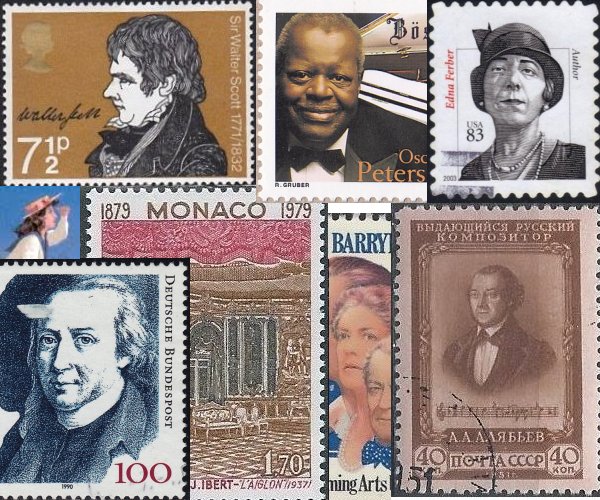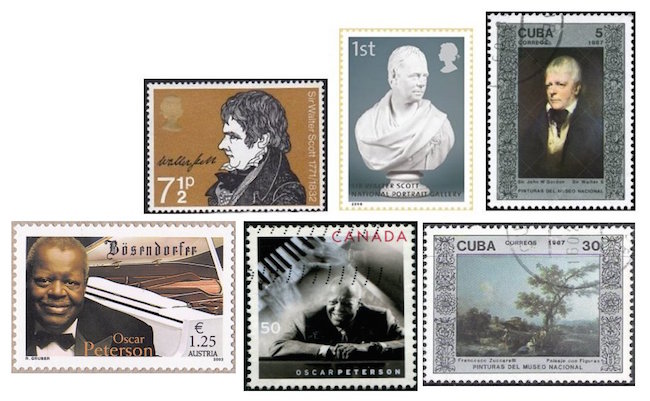The Arts on Stamps of the World — August 15
An Arts Fuse regular feature: the arts on stamps of the world.

By Doug Briscoe
August 15 is the birthday of Sir Walter Scott (1771 – 21 September 1832). His novels and poems have inspired much fine music. Perhaps the most famous opera based on his work is Donizetti’s Lucia di Lammermoor (1835), but an even earlier Scott-based opera was Rossini’s La donna del lago, which had its première in 1819, just nine years after the long poem on which it was based had been written. That poem, “The Lady of the Lake”, as translated by Adam Storck, also provided Schubert with the lyrics to a set of seven songs, including the divine “Ave Maria” (aka Ellen’s third song), D. 839. This song was also set, albeit less memorably, by both Fanny and Felix Mendelssohn. Another of Ellen’s songs set by Schubert is “Jäger, ruhe von der Jagd!”, also treated by Brahms. Several of the folk song settings of Haydn and Beethoven use Scott’s lyrics. Getting back to opera, I cite another early treatment, La dame blanche by Boieldieu (1825), which has a plot derived from no fewer than five separate Scott works, including the Waverley novel Guy Mannering. That series of historical novels inspired Hector Berlioz, just a few years later, to write, not one, but two orchestral overtures: “Waverley” and “Rob Roy.” Much later still, another Waverley novel, The Fair Maid of Perth, was made into a famous opera by Bizet (1867). Sir Arthur Sullivan’s only “serious” opera, dated 1891, is Ivanhoe. The British stamps are from sets issued in 1971 and 2006, and the Cuban one is a portrait of Scott by John Watson Gordon (1788-1864).
One of the greatest jazz pianists, Oscar Peterson (1925 – December 23, 2007), also has a birthday today. Peterson’s parents came from the West Indies, and he was born in Montreal. He studied with a piano teacher in a direct line from Liszt and was tireless at practicing. In later years he would insist that his own students study the music of Bach. Peterson won eight Grammys. There is a statue of him outside the National Arts Centre in Ottawa, unveiled by Queen Elizabeth in 2010. Besides the stamp from his native Canada, there’s one from Austria celebrating his association with Bösendorfer on the occasion of the piano manufacturer’s 175th anniversary in 2003.

By a notable coincidence, the stamp showing Landscape with Figures by Italian painter Francesco Zuccarelli (15 August 1702 – 30 December 1788) happens to come from the same set as the Cuban Walter Scott stamp! It’s a set of six stamps showing art works from Havana’s National Museum of Fine Arts. Zuccarelli was born in Tuscany to an affluent merchant and vineyard owner. At around twelve he began his apprenticeship to artists in Rome, but his first commission was for chapel altarpieces in his hometown of Pitigliano. He moved on to Florence, Bologna, Venice, and England. He collaborated with a number of other artists, notably Bernardo Bellotto and Antonio Visentini. (One of his projects with Visentini was a set of playing cards picturing figures from the Old Testament!) One of the fruits of his time in England was a scene from Shakespeare, Macbeth and the Witches (c1760). He was also a founder of the Royal Academy of Arts. He returned to Venice in 1771 and died in Florence.
Matthias Claudius (15 August 1740 – 21 January 1815) was a poet to whom Franz Schubert returned a dozen times or so, with the best known song being probably “Death and the Maiden”, a theme Schubert reused in his great eponymous string quartet. There’s a Beethoven song, too (“Urians Reise um die Welt” from Op. 52). Claudius’s verses were also commonly set by his other musical contemporaries and then by such 19th-century figures as Loewe, Humperdinck, and Reger. Claudius has remained a favorite with many composers of the 20th century, including Webern, Hindemith, Krenek, and Hanns Eisler. Claudius wrote not only poetry but also journalism and essays. Germany has issued two stamps for him, one of them referencing the newspaper of which Claudius was the editor, Der Wandsbecker Bote (The Wandsbeck Messenger).
Russian composer Alexander Alyabyev (ahl-YAHB-yeff, 15 August [O.S. August 4] 1787 – 6 March [O.S. 22 February] 1851) is best known for the song “The Nightingale” (1823), borrowed by Rossini for the lesson scene in The Barber of Seville and beloved of Tchaikovsky, whose mother sang it to him when he was a child. The song was written while Alyabyev was in exile in his birthplace of Tobolsk, having been accused of murder following the mysterious death of a man with whom he’d been playing cards all night. The evidence was inconclusive, but the composer remained in exile for six years (1825-31). In his earlier life, Alyabyev had fought as an officer in the Napoleonic Wars, taking part in the actions at Dresden and Paris. Besides “The Nightingale”, Alyabyev wrote seven operas, twenty musical comedies, a symphony, three string quartets, more than 200 songs, and many other pieces.

The Canadian painter Lucius O’Brien (15 August 1832 – 13 December 1899) was born in a town founded by his father, so I’ll bet he wasn’t bullied much as a kid. Working at first in an architect’s office, he turned to painting landscapes, which became his forte. In 1880 he became founding President of the Royal Canadian Academy of Arts. Typical of his work is a piece he painted that very year, Sunrise on the Saguenay, Cape Trinity, shown on the Canadian stamp issued one hundred years later.
Children’s author Edith Nesbit (15 August 1858 – 4 May 1924) was born in London. At eighteen, seven months pregnant, she married an habitual adulterer named Bland. She kept her promise to take on as a housekeeper a friend named Alice even after discovering that Alice had been impregnated by the hyperactive Mr. Bland. Nesbit not only adopted the child but also the one Alice bore to the insatiable Mr. Bland thirteen years later. She had three children of her own, and she and the inexhaustible Mr. Bland collaborated on book-writing as well as baby-making until Edith’s success as a writer of children’s books. In her many books she introduced a more down-to-earth reality to the kinds of worlds created by such writers as Lewis Carroll and Kenneth Grahame, though the fantasy element remains. Her best known titles include The Story of the Treasure Seekers (1898-99) and The Railway Children (1906). Her writing was admired by Noël Coward and Gore Vidal. She also wrote poetry, as well as novels and stories for adults. The British stamp from 1998 shows characters from her 1904 book The Phoenix and the Carpet.
Twice before we’ve seen this US stamp for the Barrymores, once for John and once for Lionel. Now we show it one last time for Ethel Barrymore (born Ethel Mae Blythe; August 15, 1879 – June 18, 1959). She met Oscar Wilde and may have received a marriage proposal from Winston Churchill. Her first great success on the stage was in Captain Jinks of the Horse Marines in New York in 1901. Her first film appearance was in The Nightingale in 1914, and her last was in Johnny Trouble in 1957. Barrymore won an Academy Award in the Supporting Actress category for her performance in None but the Lonely Heart (1944). She loved baseball.
Today is the also the birthday of Ivan Meštrović (15 August 1883 – 16 January 1962). His beginnings as a stonemason in his native Slavonia set the course for his future career in sculpture. A patron who recognized his talent financed his admission to Vienna’s Academy of Fine Arts, where Meštrović had to learn German from scratch. Within a very few years his work was making a name for him, and after moving to Paris in 1908 his further sculptures secured his reputation. With the close World War I he returned to the Balkans but ended his days in the United States, having become a citizen in 1954. The recent Croatian stamp was issued in 2008 for the 125th anniversary of his birth and shows his statue Croatian History (1932). This can also be seen, in profile, on the first of the earlier (1962) Yugoslavian stamps in the next row. Next to the Croatian stamp is Meštrović’s Victor (1928) in Belgrade. The other three stamps below are of Reminiscences, head of Kraljević Marko, a 14th-century Serbian king (1933), and The Spearman (1928), one of a pair of equestrian Indian statues in Chicago.

Novelist Edna Ferber (August 15, 1885 – April 16, 1968) was the child of a Jewish couple of Hungarian and German origin. She was born and grew up in the midwest—Michigan, Chicago, Iowa, Wisconsin—and worked for newspapers before writing the first of her many novels in 1911. Ferber won the Pulitzer for So Big (1924), which was made into three movies during her lifetime (1925, 1932, 1953). She was very doubtful about the idea of making Show Boat (1926) into a musical until personally reassured by Jerome Kern. She also authored Giant in 1952 (made into the movie with Elizabeth Taylor, Rock Hudson and James Dean in 1956) and co-wrote a number of plays with George S. Kaufman, who like Ferber was a member of New York’s scintillating Algonquin Round Table.
Jacques Ibert (1890 – 5 February 1962) interrupted his musical studies to serve in the French navy during World War I, but shortly thereafter he won the Prix de Rome at his very first attempt. He was director of the Académie de France at the Villa Medici in Rome from 1937 to 1960, with an enforced hiatus during the Second World War. Ibert’s best known work, I suppose, is the orchestral triptych “Escales” or “Ports of Call” from 1922, a musical portrait of various Mediterranean cities. The only Ibert stamp I can find is one from Monaco that commemorates the opera L’Aiglon (The Eaglet, 1937), for which Ibert wrote only Acts 1 and 5, the rest having been composed by Arthur Honegger. Be sure to check out the children’s lullabies by Ibert’s brother Ted.
In 2014 the USPS issued a block of five designs honoring popular American chefs, and today is the birthday of the mother of them all, Julia Child (August 15, 1912 – August 13, 2004).
There’s no stamp for Thomas De Quincey (15 August 1785 – 8 December 1859), English author of Confessions of an Opium Eater (1822) and “On Murder Considered as one of the Fine Arts” (1827).
A graduate of the University of Massachusetts with a B.A. in English, Doug Briscoe worked in Boston classical music radio, at WCRB, WGBH, and WBUR, for about 25 years, beginning in 1977. He has the curious distinction of having succeeded Robert J. Lurtsema twice, first as host of WGBH’s weekday morning classical music program in 1993, then as host of the weekend program when Robert J.’s health failed in 2000. Doug also wrote liner notes for several of the late Gunther Schuller’s GM Recordings releases as well as program notes for the Boston Classical Orchestra. For the past few years he’s been posting a Facebook “blog” of classical music on stamps of the world, which has now been expanded to encompass all the arts for The Arts Fuse.
